
Content marketing takes many forms; blog posts, videos, podcasts, social media content, and more, with each playing a vital role in attracting and engaging audiences.
And understanding how different content types perform can help you refine your marketing strategy and drive better results.
We’re Digitaloft, an award-winning content marketing agency, and we’ve gathered the most important content marketing statistics you need to know in 2025 to help you stay ahead.
From the dominance of short-form video and AI-powered content creation to the continued growth of podcasting and mobile-first strategies, these insights will help you attract users, boost brand awareness, and maximise your content marketing ROI.
Ready to refine your marketing strategy with data-driven insights?
Let’s dive into the numbers shaping the content marketing industry in 2025.
The top 10 content marketing statistics you need to know in 2025…
1. The average blog post now stands at 1,427 words, over 70% longer than a decade ago.
2. 83% of consumers want to see more video content from brands in 2025.
3. Infographics are 30x more likely to be read than articles and can boost website traffic by 12%.
4. One in two writers use AI tools to boost the performance of their content.
5. 89% of B2B marketers use LinkedIn for lead generation, and 62% say it produces leads for them.
6. 65% of B2C marketers say they frequently or always differentiate their content from competitors.
7. 82% of SaaS companies use the challenge/solution/results format for case studies.
8. The average engagement rate on Instagram is 0.43%, compared to 0.063% on Facebook and 0.029% on X/Twitter.
9. 94% of blog posts earn zero backlinks.
10. Generating fresh ideas (16%), driving engagement (16%), and attracting traffic (15%) top marketers’ list of challenges.
Blogging statistics.
Blogging remains a cornerstone of content marketing, driving organic traffic, leads, and thought leadership. These stats highlight why brands continue to invest in blog content, and how AI and long-form strategies are shaping its future.
1. Blogging is the most popular content format – 90% of marketers use blog content to meet their marketing goals
Despite the rise of video and interactive formats, blogging remains the backbone of content marketing.
It’s a key driver of organic search traffic, thought leadership, and lead generation – especially when integrated into a wider SEO strategy with keyword optimisation, internal linking, and multimedia elements.
2. Companies that maintain an active blog produce 67% more leads per month than those without one
This reinforces the ROI of content marketing, particularly for B2B brands and industries with long sales cycles. Consistently publishing high-value, search-optimised content builds trust, nurtures potential customers, and increases organic traffic… all essential for long-term growth.

3. 43% of content marketers use AI to generate ideas, but only 3% rely on it to write full articles
AI-powered tools like ChatGPT and Jasper are transforming brainstorming, content planning, and research; but human input remains essential for originality, brand voice, and audience engagement.
Marketers leveraging AI as an assistant rather than a replacement will produce more authentic, high-quality content that resonates with readers.
4. The average blog post now stands at 1,427 words, over 70% longer than a decade ago
However, just 3% of brands consistently publish blog content exceeding 2,000 words. This suggests that while long-form content has SEO benefits, many marketers prioritise concise, digestible pieces over extensive deep dives.
A balanced content marketing approach requires a strategic mix of short–and long-form content aligned with search intent and audience needs.
Social media marketing statistics.
From engagement rates to platform usage trends, social media continues to evolve rapidly. These stats reveal how marketers are navigating shifting algorithms, user behaviours, and channel preferences in 2025.
1. The average engagement rate on Instagram is 0.43%, compared to 0.063% on Facebook and 0.029% on X/Twitter
Instagram consistently outperforms other social media platforms in engagement, making it an ideal choice for brands focused on organic reach. Facebook and X/Twitter struggle in this area, indicating that paid promotions may be necessary to gain traction on those channels.
2. Over three-quarters (76%) of small businesses surveyed are using Facebook as part of their social media marketing, followed by Instagram at 63%, and LinkedIn at 43%
Small businesses lean heavily on Facebook due to its reach and ad-targeting capabilities. However, LinkedIn’s growing adoption highlights its effectiveness for B2B marketing.
Diversifying across platforms ensures broader audience engagement.
3. Optimal send times for Facebook are Mondays through Sundays, starting either at 8 or 9 a.m., with time extending to noon on a handful of days
Posting at peak engagement times can significantly impact reach and visibility. While these time slots provide a guideline, performance varies by industry and audience. Testing different posting schedules is crucial for refining content strategies.
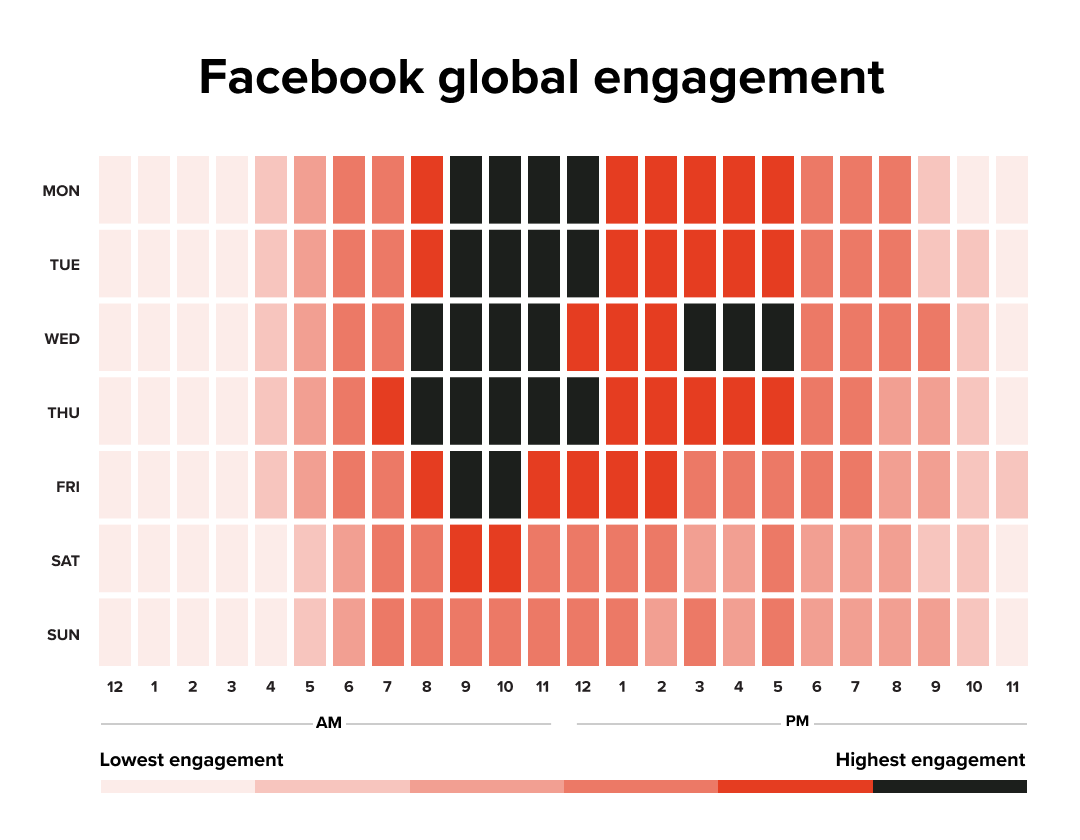
4. The best times to post on Instagram are generally Mondays through Thursdays between 10 a.m. and 3 p.m.
Timing matters when competing for attention on social media. Mid-morning engagement spikes suggest that users are most active before lunch.
For brands using Instagram for content marketing, scheduling posts around these times could boost visibility.
5. Facebook has over 3 billion monthly active users, more than any other social media platform
With the largest audience, Facebook remains a vital platform for businesses. However, its vast user base doesn’t guarantee engagement.
Marketers should focus on creating highly targeted content to cut through the noise and reach the right demographics.
6. 1.3% of all online articles receive 75% of social shares
The majority of content struggles to gain traction, emphasising the importance of quality over quantity.
Standing out requires compelling storytelling, data-driven insights, and strategic distribution across multiple platforms.
7. 96% of top Pinterest searches are unbranded
Pinterest users often search for general ideas rather than specific brands, offering a prime opportunity for discovery.
Brands can leverage this by optimising pins for relevant keywords and focusing on inspiring, actionable content.
8. 66% of marketers planned to maintain their brand presence on X in 2023, but 71% spent less time on the platform
X remains a secondary platform for many marketers. While some brands see value in maintaining a presence, reduced investment suggests that other platforms may provide better ROI. Testing different channels can help determine where efforts are best spent.
Video marketing statistics.
Video is no longer optional, it’s an essential part of content marketing. These stats showcase how short-form, educational, and platform-specific videos are fuelling engagement, conversions, and brand storytelling across the funnel.
1. Video marketing strategy dominates – Over three-quarters (77%) of marketers use social video, while 61% incorporate branded stories and 59% create how-to videos in their campaigns
The dominance of video highlights how brands are shifting toward engaging, visual storytelling to stand out in crowded digital spaces.
Short-form and interactive videos are particularly effective at driving brand awareness and audience retention across social platforms.
2. Video drives traffic – 87% of marketers say video marketing has helped them increase website traffic
With search engines prioritising engaging and multimedia-rich content, video plays a key role in content distribution strategies.
Embedding optimised video on blog posts, landing pages, and product pages can improve engagement, encourage longer session durations, and contribute to higher rankings in organic search.
3. 84% of content marketers report that video delivers results that meet or exceed expectations
Strong engagement metrics, from watch time to social shares, suggest that video is no longer just a brand awareness tool; it also plays a role in conversion-driven campaigns. As competition for attention increases, content marketers must ensure video strategies are data-led, optimising formats, lengths, and messaging for audience preferences.
4. YouTube (85%), LinkedIn (84%), and Facebook (67%) are the most popular channels for video distribution
Each platform serves a distinct purpose:
- YouTube is key for evergreen, searchable content like tutorials and deep dives.
- LinkedIn is a growing hub for B2B thought leadership and industry insights.
- Facebook remains valuable for community-building and social engagement.
A multi-channel approach ensures video content reaches audiences where they are most active.
5. Rising consumer demand – 83% of consumers want to see more video content from brands in 2025
This shift indicates that audiences expect brands to communicate through visual content rather than text-heavy formats. For content marketers, this means prioritising dynamic, engaging, and value-driven videos across websites, email campaigns, and social platforms.
6. Short videos are key for product discovery – 44% of consumers prefer short-form videos when learning about a product or service
Platforms like TikTok, Instagram Reels, and YouTube Shorts are driving a shift toward bite-sized, high-impact content that quickly communicates key selling points.
Brands that adapt their storytelling to short-form formats will be better positioned to engage potential customers in high-intent moments.
7. The average retention rate for videos under 1 minute long is 66%
Capturing attention in the first few seconds is essential, making hook-driven intros, fast-paced storytelling, and clear CTAs non-negotiable in 2025’s content landscape.
With social algorithms favouring completion rates, concise yet engaging videos can maximise visibility and performance.
8. YouTube dominates watch time – Android users alone clock over 10 trillion minutes per month watching YouTube videos globally
As the second-largest search engine, YouTube is a major player in content discovery and brand visibility.
Marketers should adopt a search-first approach to video strategy, optimising titles, descriptions, and tags for discoverability on YouTube and in Google search results.
9. 96% of video marketers agree that videos have helped increase users’ understanding of their product or service
This highlights the power of video content in educating audiences and guiding them through the customer journey. Explainer videos and testimonial videos help simplify complex topics, address objections, and build trust.
Video drives organic search, website traffic, and engagement on social media platforms, so investing in video as a marketing tool is key to boosting conversions.
Visual content marketing statistics.
Visuals remain powerful tools for grabbing attention and communicating quickly. These stats show how infographics, images, and design-led content are being used to elevate campaigns and boost ROI.
1. Nearly 30% of marketers say images are the second most used content format after short-form videos
Despite video’s dominance, images remain a core part of content marketing strategies, driving engagement across social media ads, email marketing, and websites.
With AI tools making image creation easier, standing out requires high-quality, on-brand visuals. A balanced mix of short-form video, infographics, and strong imagery can enhance content marketing ROI and boost brand awareness.
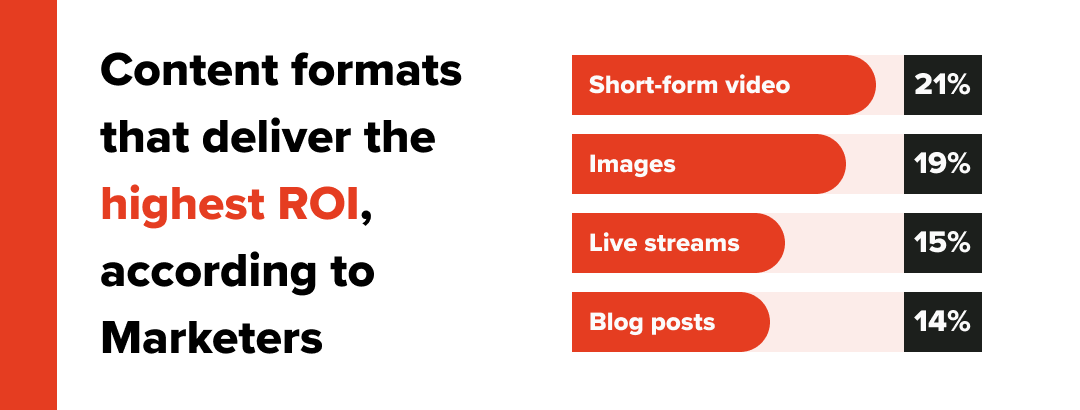
2. Infographics are 30x more likely to be read than articles and can boost website traffic by 12%
This reinforces the power of visual content in a world where internet users skim rather than read. Infographics provide an at-a-glance way to consume information, making them effective for content marketing efforts across social media platforms and business websites.
Their ability to drive organic search and improve SEO strategies highlights why they should be part of any strong content marketing strategy.
3. 55% of marketers prioritise social media infographics over other visual content
With social media ads and short-form video dominating feeds, infographics offer a quick and engaging alternative that captures attention. As part of social media marketing strategies, they help brands simplify messages, boost shares, and support social media advertising efforts.
Their effectiveness in creating brand awareness and generating leads makes them a must-have for social media marketers.
4. 43% of marketers struggle to produce consistently high-quality visual content
Despite their effectiveness, producing infographics at scale is a challenge. Balancing content creation with maintaining high standards requires marketing teams to invest in AI tools, design expertise, and efficient marketing tech stacks.
As content marketing efforts evolve, finding scalable ways to produce valuable content formats will be key to standing out in crowded feeds.
Podcasting statistics.
Podcasting has gone mainstream, and the numbers prove it. These stats explore who’s listening, where they’re tuning in, and why audio should be part of your content mix in 2025.
1. Millennials currently account for 32.7% of podcast consumers in the US (44.3 million individuals), with Gen Z following closely at 28.9% (39.1 million people)
Millennials and Gen Z dominate the podcast space, making it a valuable content format for brands targeting younger, digitally native audiences.
With social media marketing strategies increasingly incorporating audio content, leveraging podcast ads and collaborations can boost brand awareness and reach engaged listeners.
2. Spotify accounts for 31.8% of podcast listeners in the US
As Spotify continues to lead in podcast streaming, marketers should consider platform-specific strategies. Native Spotify podcast ads, influencer marketing within podcasts, and AI-driven ad targeting can enhance content marketing ROI and drive social media engagement.
3. On average, weekly podcast listeners listened to 8.3 podcast episodes in the past week
Podcast audiences are highly engaged, listening to multiple episodes weekly. This presents an opportunity for brands to develop long-form content strategies, including interview-style episodes, explainer podcasts, and industry insights that align with search engine optimisation strategies.
4. The average time spent per day with podcasts among US users amounted to 28 minutes in 2024
Podcast listening is a daily habit, offering a prime space for content marketers to deliver valuable, non-intrusive marketing messages.
Short-form video content and social media ads can complement podcast strategies, ensuring multi-channel engagement throughout the customer journey.
5. Ad spending in the digital audio advertising market is projected to reach US$12.16bn in 2025, with a projected market volume of US$15.47bn by 2030
With growing investment in podcast and audio advertising, businesses should integrate audio content into their marketing tech stack. The rise of programmatic podcast ads and AI-driven targeting presents new opportunities to refine social media advertising and content marketing efforts.
AI content statistics.
AI is reshaping content marketing; from ideation and copywriting to email and optimisation. These stats highlight how marketers are using generative AI to work smarter, not just faster.
1. 89% of marketers say they use generative AI tools
AI is now embedded in content marketing strategies, streamlining processes from content creation to email marketing.
However, human oversight remains crucial to ensure AI-generated content maintains authenticity and aligns with brand voice.
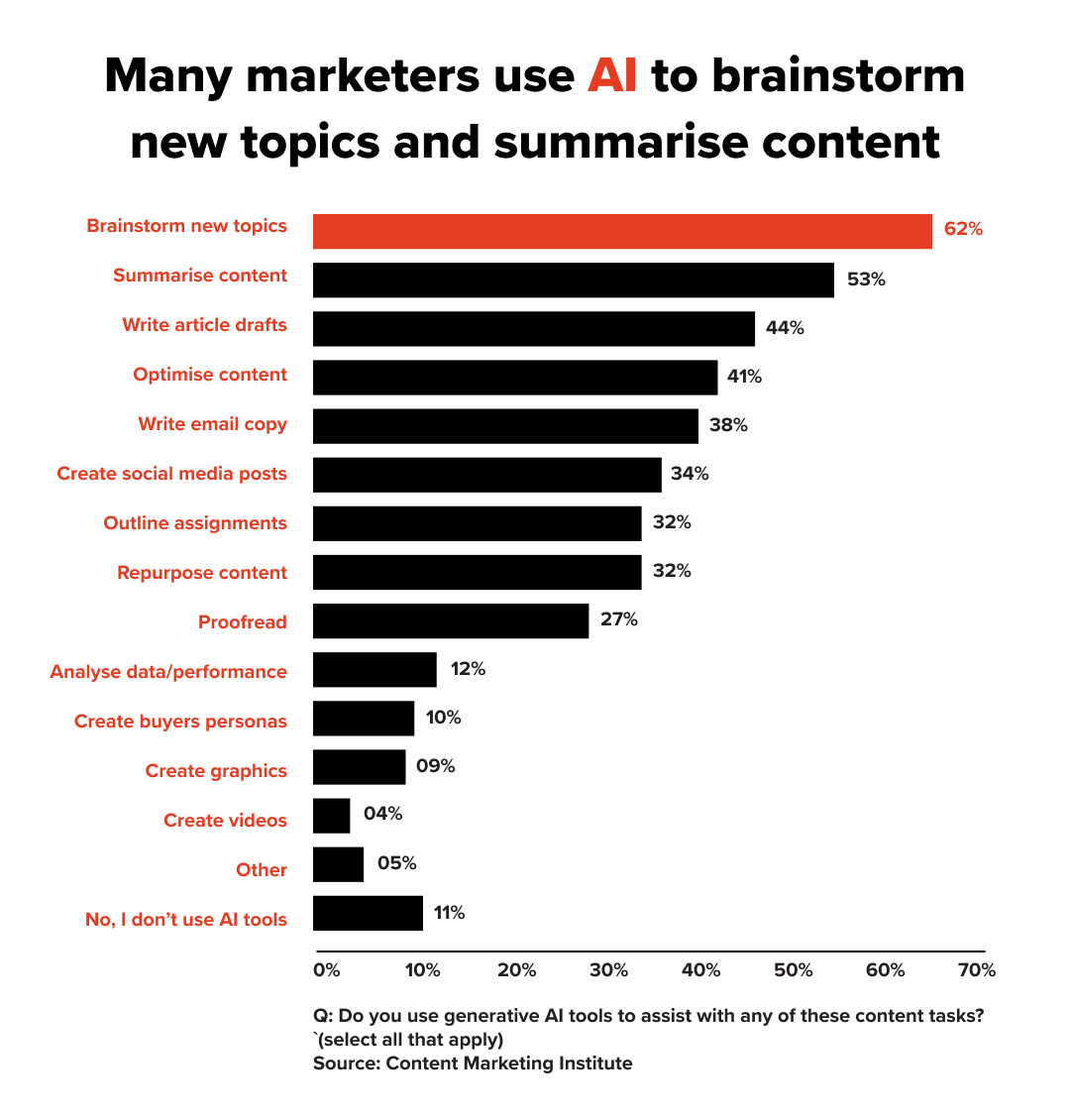
2. One in two writers use AI tools to boost the performance of their content
AI-powered content optimisation is becoming standard practice, helping marketers refine SEO strategies, personalise email copy, and generate leads through more effective messaging. Leveraging AI tools strategically can boost brand awareness and increase website traffic.
3. 95% of marketers who use generative AI for email creation rate it as ‘effective,’ and 54% rate it as ‘very effective’
AI-driven email marketing enhances efficiency and personalisation, making it a key marketing tool. With mobile devices driving high email open rates, AI-optimised content can improve engagement and drive conversions.
4. 43% of marketers who use generative AI say that it’s most helpful for creating email copy
Email marketing remains a priority, with AI improving efficiency and A/B testing capabilities. AI-generated content can also support content marketers in repurposing key insights across multiple formats, from social media ads to blog content.
B2B content marketing statistics.
B2B content marketing is increasingly driven by data, personalisation, and platforms like LinkedIn. These stats reveal what’s working, where budgets are going, and how B2B brands are using AI and content to generate leads.
1. 40% of B2B marketers rank LinkedIn as the most effective platform for lead generation
In fact, 89% of B2B marketers use LinkedIn for lead generation, and 62% say the platform produces leads for them.
LinkedIn is a key channel for B2B marketing. Decision-makers and professionals actively engage with industry content, making LinkedIn an essential platform for brands looking to establish credibility and drive leads.
2. Over 72% of B2B marketers use generative AI tasks for content tasks
AI is reshaping B2B content marketing strategies, enabling faster content creation and improved personalisation. From explainer videos to thought leadership blogs, AI-driven insights can refine marketing efforts and enhance content marketing ROI.
3. 89% of B2B marketers use LinkedIn for lead generation, and 62% say it produces leads for them
LinkedIn remains the dominant platform for B2B marketing, offering a direct line to decision-makers and industry professionals.
With its robust targeting options and content-driven approach, marketers can optimise LinkedIn for demand generation through thought leadership posts and LinkedIn Ads.
B2C content marketing statistics.
B2C brands are blending digital content with in-person experiences, prioritising owned media, and investing in video. These stats unpack how consumer-focused marketers are adapting in a crowded, competitive landscape.
1. B2C content produces 9.7x more shares than content on B2B sites
However, the distribution of shares and links for B2B and B2C publishers appears to be similar.
2. 48% of B2C marketers say in-person events produced the best content marketing results in the past year
Despite the digital shift, face-to-face interactions remain a powerful content marketing tool. Events foster brand trust and direct engagement, making them ideal for high-consideration purchases.
However, short-form articles (47%) and videos (45%) remain crucial, reinforcing that a strong mix of in-person and digital content is essential for a successful content marketing strategy.
3. 87% of B2C marketers use company websites to distribute content, followed by blogs (76%) and email newsletters (68%)
Owned media remains the backbone of B2C content distribution. A well-optimised website drives organic search traffic, blogs build authority, and email newsletters nurture customer relationships.
With the decline of organic reach on social media platforms, these owned channels provide marketers with greater control over audience engagement and brand messaging.
4. Paid content distribution among B2C marketers dropped from 78% to 63% in one year
The decrease in paid content distribution suggests a shift toward organic reach and owned media.
While social media ads and SEM remain essential, marketers are likely prioritising SEO strategies, content optimisation, and audience-building techniques to maximise long-term sustainability over short-term paid reach.
5. 31% of B2C marketers invest at least 50% of their marketing budget in content marketing
Content marketing is no longer an add-on; it’s a core investment. Brands dedicating significant budgets to content creation, SEO strategies, and video production are seeing the value in long-term brand-building over short-term ad spending.
6. 65% of B2C marketers say they frequently or always differentiate their content from competitors
Standing out in a crowded content landscape requires a unique voice, innovative storytelling, and audience-first strategies.
Brands that succeed in differentiation create quality content that aligns with customer needs while leveraging video marketing, influencer collaborations, and personalised experiences.
SaaS content marketing statistics.
For SaaS marketers, storytelling with substance matters. These stats show how case studies, metrics, and structured formats are driving sales, and where there’s room to stand out by going beyond the template.
1. 49% of SaaS marketers said that case studies are ‘very effective’ at boosting sales
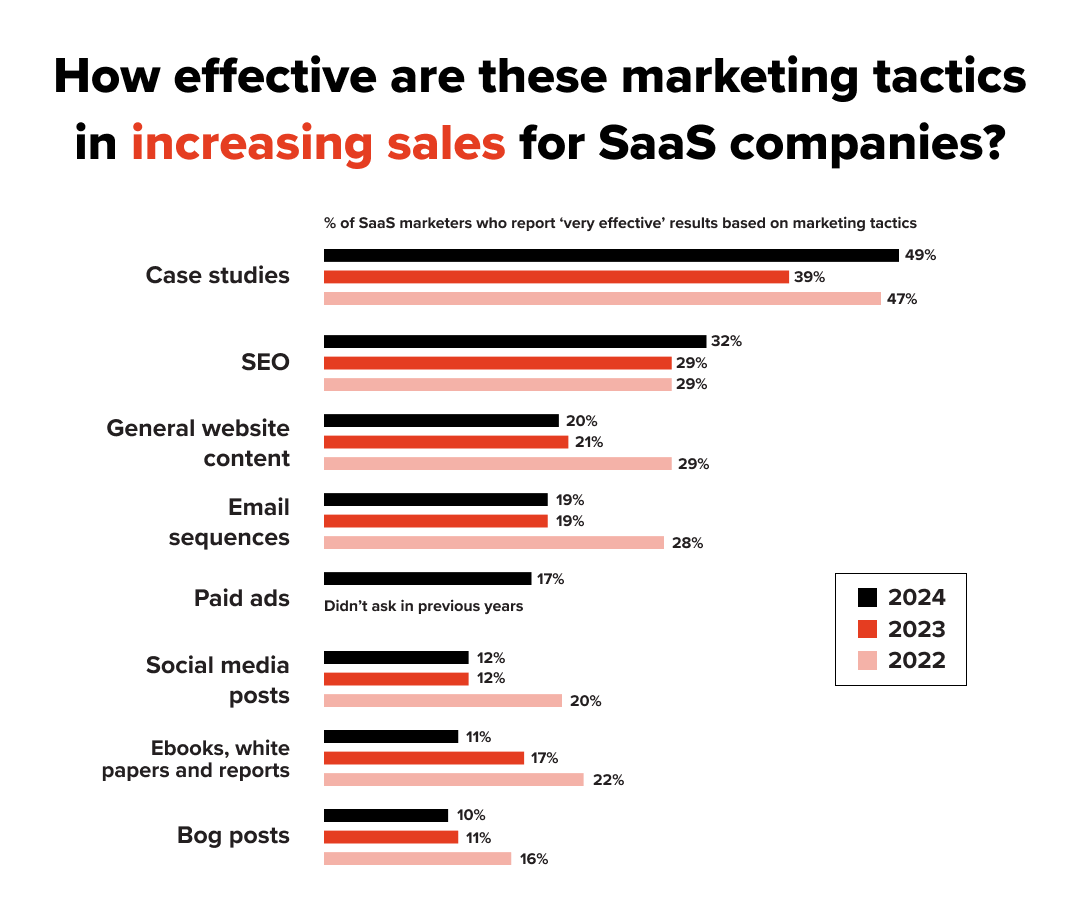
2. 82% of SaaS companies use the challenge/solution/results format for case studies
The challenge/solution/results framework remains a staple in SaaS case studies for a reason – it’s clear, structured, and results-driven. With such a high adoption rate, it’s evident that data-backed storytelling is a priority in the industry.
However, as audiences become more sophisticated, there’s an opportunity to go beyond this formula. Adding real customer voices, industry context, or before-and-after comparisons can make case studies more engaging and authentic.
SaaS marketers who evolve their approach stand a better chance of cutting through the noise and proving value in a crowded market.
3. Only 8% of SaaS companies have case studies without any metrics
Numbers matter, especially in case studies and success stories. With 92% of SaaS companies incorporating metrics, it’s clear that data-driven storytelling is the norm.
Concrete figures help establish credibility, making case studies more persuasive for potential buyers.
The content marketing landscape in 2025: Key stats & industry shifts.
Content marketing is evolving fast, shaped by new tools and technologies, tighter budgets, and rising expectations. These industry-wide stats offer a snapshot of the biggest shifts, and what they mean for your strategy.
1. 94% of blog posts earn zero backlinks
Earning backlinks is a major hurdle in content marketing, with the vast majority of blog posts failing to attract even a single link.
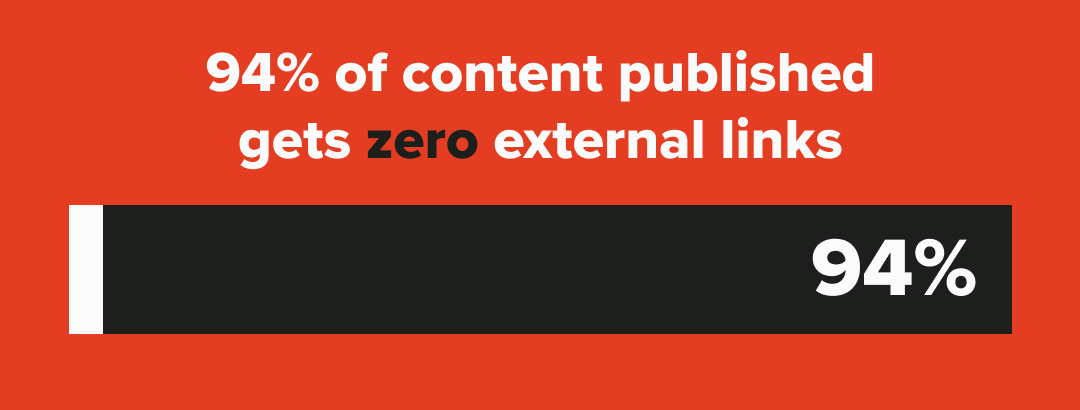
Securing links from multiple domains is even rarer, with just 2.2% of content achieving this. This highlights the importance of producing highly valuable, well-researched content and promoting it strategically to increase visibility and authority.
2. The average annual salary for content marketers in the US is $112,000
Content marketing remains a lucrative field, with an average annual salary of $112,000. As demand for high-quality, data-driven content grows, so does the need for skilled professionals who can blend creativity with strategic execution.
3. Generating fresh ideas (16%), driving engagement (16%), and attracting traffic (15%) top marketers’ list of challenges
With competition at an all-time high, effective content strategies require a balance of SEO, audience insights, and multi-channel distribution to cut through the noise.
4. 23% of marketing professionals say content marketing had the biggest impact on their multi-channel strategy
Nearly a quarter of marketers (23%) credit content marketing as the most impactful part of their multi-channel strategy; behind social media (46%), email marketing (45%), and digital ads (26%).
While content alone isn’t the dominant force, its ability to fuel other channels makes it an essential investment.
Content marketing predictions for the next 12 months.
The content marketing landscape is evolving rapidly, and brands that adapt will have the biggest impact.
As businesses tighten budgets, AI becomes more sophisticated, and audience expectations shift, 2025 will be a year of smarter, more strategic content.
Here’s what’s coming, and how to stay ahead.
‘Do more with less’ will shape content strategy.
Ellie Wraith, Content Lead at Digitaloft:
Business leaders will continue pushing teams to ‘do more with less,’ but that doesn’t mean churning out endless content. Instead, the focus will shift to delivering higher-quality results with fewer, more strategic assets.
AI will remain a key tool, not for mass-producing content, but for enhancing research, streamlining workflows, and personalising messaging. Brands that succeed will use AI to create highly targeted, high-impact content rather than flooding channels with generic material.
This means marketers will need to work smarter: refining strategies, leveraging data, and focusing on content that truly engages and converts. The brands that win in 2025 won’t be the loudest, they’ll be the most relevant.
Motion will play a bigger role in content engagement for mobile-first audiences.
Faye Baxter, Head of Design & Development:
Mobile consumption habits will drive a shift in design, with motion playing a bigger role in content engagement. Expect more dynamic, interactive visuals that make an impact within seconds.
Short-form videos and animated graphics will dominate, helping brands communicate key messages quickly and effectively. Striking statistics, bold visuals, and snackable content will take centre stage, ensuring audiences absorb and retain information.
To enhance these experiences, expect to see more voiceovers and audio integration, blending motion, sound, and interactivity for a more immersive content experience. The goal? Making content not just seen, but felt.
What this means for content marketers.
In 2025, success won’t come from simply producing more content; it will come from creating the right content. Strategic storytelling, data-driven insights, and audience-first thinking will separate brands that make an impact from those that get lost in the noise.
See more of our experts’ content, SEO & Digital PR predictions for 2025.
Methodology and sources.
This content marketing statistics page was created by the Digitaloft team using a combination of in-house expertise and trusted industry research.
We’ve compiled data from leading sources – including Backlinko, the Content Marketing Institute, and HubSpot – to provide a comprehensive look at the latest content trends and benchmarks for 2025.
- https://www.orbitmedia.com/blog/blogging-statistics/
- https://www.wyzowl.com/video-marketing-statistics/
- https://www.demandsage.com/infographic-statistics/
- https://www.hubspot.com/marketing-statistics
- https://sproutsocial.com/insights/linkedin-statistics/
- http://contentmarketinginstitute.com/wp-content/uploads/2023/01/B2C_2023_Research_Final.pdf
- https://www.upliftcontent.com/blog/saas-marketing-case-studies/
- https://www.rivaliq.com/blog/social-media-industry-benchmark-report/
- https://backlinko.com/content-study
- https://www.hubspot.com/state-of-marketing
- https://www.semrush.com/blog/content-marketing-statistics/
- https://www.demandmetric.com/content/content-marketing-infographic
- https://localiq.com/blog/small-business-marketing-trends-report/
- https://sproutsocial.com/insights/best-times-to-post-on-social-media/#facebook
- https://www.statista.com/statistics/272014/global-social-networks-ranked-by-number-of-users/
- https://business.pinterest.com/en-gb/audience/
- https://contentmarketinginstitute.com/articles/video-content-research/
- https://datareportal.com/reports/digital-2024-deep-dive-the-time-we-spend-on-social-media
- https://www.vidyard.com/business-video-benchmarks/
- https://www.emarketer.com/learningcenter/guides/the-podcast-industry-report-statistics/
- https://www.edisonresearch.com/the-infinite-dial-2024/
- https://www.statista.com/outlook/amo/advertising/audio-advertising/digital-audio-advertising/worldwide
- https://contentmarketinginstitute.com/articles/content-marketers-ai-content-tools
- https://sproutsocial.com/insights/linkedin-statistics/
- https://www.upliftcontent.com/blog/saas-marketing-case-studies/
- https://ascend2.com/wp-content/uploads/2023/04/Multi-Channel-Marketing-2023-Survey-Summary-Report-230427.pdf



